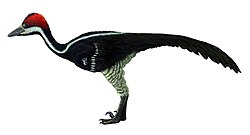| Papiliovenator Temporal range: Campanian | |
|---|---|
 | |
| Holotype skull diagram | |
| Scientific classification | |
| Domain: | Eukaryota |
| Kingdom: | Animalia |
| Phylum: | Chordata |
| Clade: | Dinosauria |
| Clade: | Saurischia |
| Clade: | Theropoda |
| Family: | † Troodontidae |
| Genus: | † Papiliovenator Pei et al., 2022 |
| Species: | †P. neimengguensis |
| Binomial name | |
| †Papiliovenator neimengguensis Pei et al., 2022 | |
Papiliovenator (meaning "butterfly hunter", after a butterfly-shaped feature on its first two dorsal vertebrae) is a genus of troodontid theropod dinosaur from the Bayan Mandahu Formation of Inner Mongolia, China. The type and only species is Papiliovenator neimengguensis. [1]

